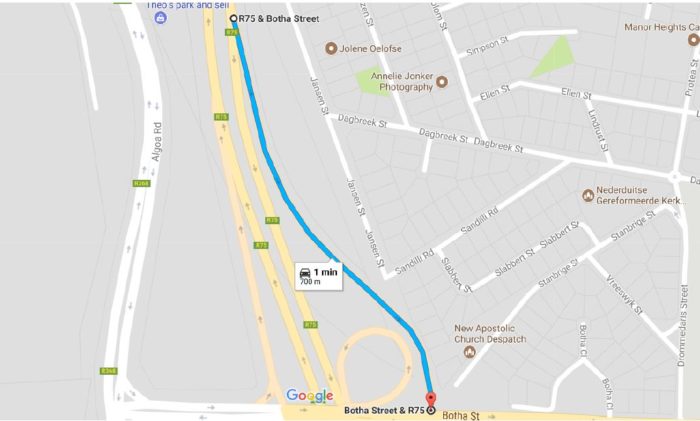Work on one of Nelson Mandela Bay’s primary arterial roads expected to be finished next year.

The South African National Roads Agency (SOC) Limited (SANRAL) announced that the R75 Section 1 rehabilitation and safety measurement improvements project currently taking place between Port Elizabeth and Despatch, has reached its half-way mark.
The R316-million project is on one of Nelson Mandela Bay’s primary arterial roads.
The R75 connects some of the oldest suburbs and townships along the route and is a vital link between Port Elizabeth and the industrial areas of Uitenhage and Despatch.
SANRAL took ownership of the R75 after it was declared a national road in April 2012. As part of its mandate, the roads agency is responsible for maintaining this important road infrastructure.
Mbulelo Peterson, SANRAL Southern Region Manager, said: “Route R75, one of the major National Roads within the Eastern Cape interior, is the primary arterial road for Algoa Park, Zwide, Zinyoka (Govan Mbeki), Veeplaas, Missionvale, New Brighton, KwaDwesi, KwaDwesi Extension, KwaMagxaki, Joe Slovo and Despatch, acting as the public transport link between both ends.”
The implementation of road safety measures and rehabilitation of the R75 Section 1 constitutes 13km and will create work for a minimum of 37 local SMMEs between 1CE PE and 6 CE PE CIDB grading within the Nelson Mandela Bay Metro.
This two-year project should be completed in May 2019.
Pedestrian facilities improved
The average daily traffic on this road ranges from approximately 6100 to 7100 vehicles per day in the northbound direction, and between 5500 and 5900 vehicles each day in the southbound direction.
The average percentage of heavy vehicles that make use of the road is around 8.5%. This means that around 500 trucks use this road in each direction every day.
Current construction is focused on rehabilitating the previously poor condition of the road surface as well as improving pedestrian safety, specifically for scholars crossing the very busy route.
There are more than 4598 (2659 adults and 1939 children) pedestrians making use of the road, 42% of them being school-going children attending the Khwezi Lomso High School (Zwide), Thyilulwazi Primary School (Zwide), Gareth Primary School (Zwide), KwaMagxaki High School (KwaMagxaki), Lungisa High School (KwaDwesi) and Nelson Mandela University (Missionvale Campus), which are situated on either side of the road.
“The poor road condition prior to the rehabilitation required constant patchwork repairs. Pedestrian facility improvements are a major requirement of this project as pedestrian movements are largely uncontrolled and unsafe. In addition, this section of road has been recognised as having some of the highest pedestrian accident numbers in the Eastern Cape,” Peterson said.
Construction divided into two phases
Due to the nature of the safety improvements required – namely improvements to both the interchange and pedestrian bridge positions – and, to expedite construction, the project was sub-divided into two phases:
- Phase 1, which is currently in construction consists of road rehabilitation and minor safety measures to improve pedestrian mobility and safety along the R75 between residential and industrial areas. The Phase 2 project will deal with the major safety improvements on the project.
- Phase 2, will consist of an upgrade to the Commercial Road interchange and the construction of a pedestrian bridge. This phase is expected to be constructed in the next three years.
The scope of work for the project entails road rehabilitation works, drainage infrastructure, pedestrian safety and fencing, and erecting guardrails.
New asphalt surface
Due to the poor condition of the road and the strategic importance of this road as a corridor between Uitenhage and Port Elizabeth, it was important to rehabilitate the road structure to ensure it would last for a further 20 years. This includes the recycling of the existing road substructure and applying a new asphalt surfacing. The asphalt surfacing is very durable, will improve the rideability of the road and reduce noise pollution.
Drainage Infrastructure
Drainage infrastructure along the entire route will be improved. Drainage infrastructure improvements includes:
- shaping or clearing of blocked drainage systems;
- installation of kerbs at all intersections and along the first 5km of the road;
- installation of subsurface drainage in cut areas; and
- installation of concrete side drains in cut areas.
Pedestrian safety and fencing
Dangerous conditions along the R75, including uncontrolled crossings of pedestrians, animals and vehicles, have been a major cause for concern. This rehabilitation and road safety project aims to prohibit these movements and crossing will only be allowed where it is safe and where deemed necessary.
An anti-climb fence system is being constructed along the R75 road reserve where no fences are currently in place.
This will help to prevent vehicles and pedestrians from gaining access to the busy R75 road at any point. Access to the road for pedestrians will be provided at intersections and at pre-defined intermediate pedestrian crossings.
An assessment of the road in March 2016 revealed that the existing pedestrian walkways were substandard and in a very poor condition. Additionally, at many sections along the route there were no pedestrian walkways.
Therefore, new walkways will be constructed along the length of the route. The walkways will generally be 2m wide, reduced to 1.5m where limited pedestrian traffic is expected, and space is restricted.
Due to level changes to the road following rehabilitation, all existing guardrails will be removed and if re-usable, will be stored for re-erection.
New and re-usable guardrails will be installed adjacent to both sides of the north and southbound carriageways to prevent vehicular traffic from making illegal crossings of the road and to prevent U-turn manoeuvres in the median. Openings will be provided in the median guardrails for emergency vehicle access and pedestrian crossings.

